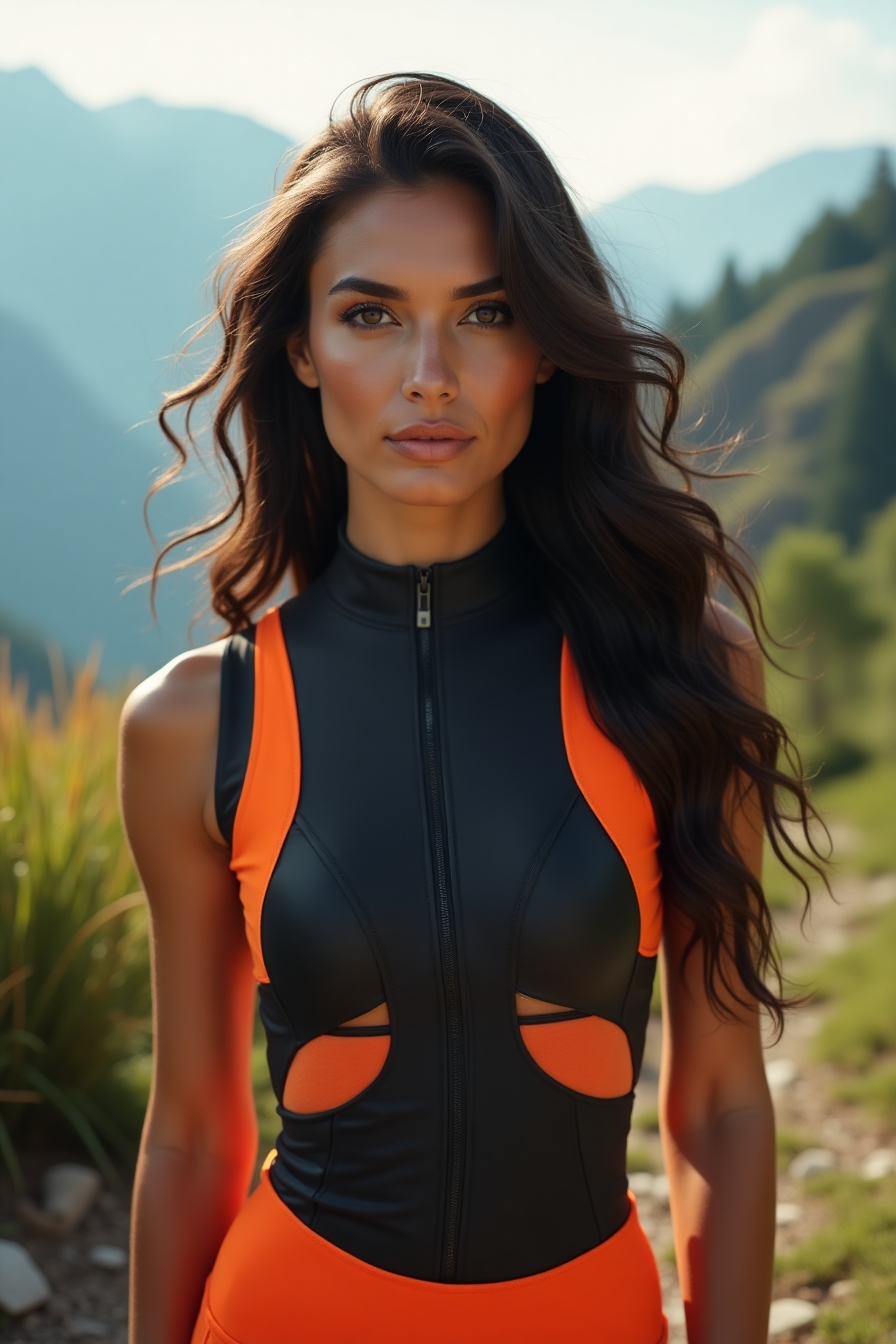Nothing beats the thrill of conquering a mountain trail while looking absolutely fabulous.
Today’s outdoor enthusiasts aren’t just packing water and trail mix—they’re serving serious style on the switchbacks.
The modern hiking wardrobe has evolved far beyond the basic khaki pants and bulky boots of yesteryear, blending function with jaw-dropping aesthetics that transition seamlessly from summits to social media.
The Mountain Minimalist
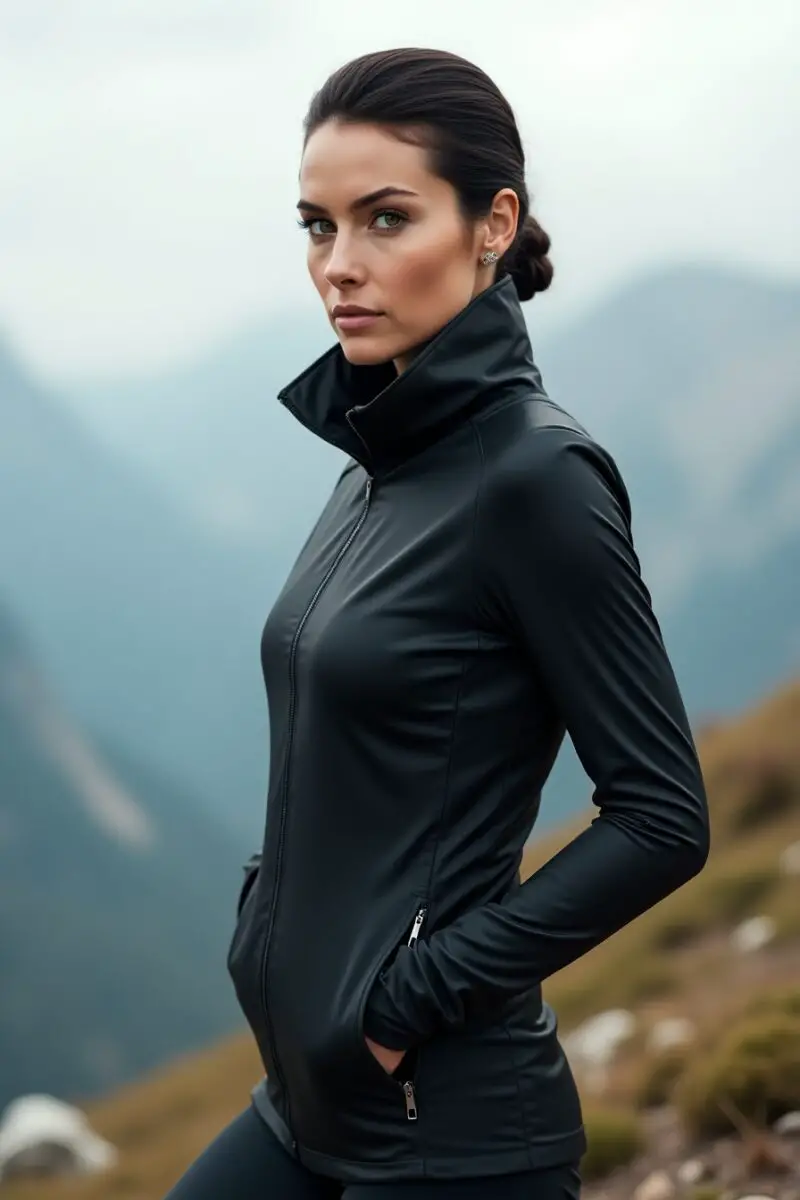
The minimalist hiking aesthetic is taking the outdoor world by storm with its clean lines and neutral color palette that perfectly complements natural landscapes.
Think buttery soft leggings in earth tones paired with perfectly fitted moisture-wicking tops that sculpt and flatter without restricting movement.
The beauty of this aesthetic lies in its versatility – each piece works harmoniously with others, allowing for endless combinations with just a handful of quality items.
These outfits feature technical fabrics that regulate body temperature while maintaining a sleek, unfussy silhouette that looks effortlessly put-together.
Brands are now engineering these minimalist pieces with hidden pockets, reinforced knees, and anti-odor technology, proving that simplicity doesn’t mean sacrificing functionality.
The color scheme typically revolves around oatmeal, olive, sandstone, and charcoal – hues that photograph beautifully against both lush forests and desert landscapes.
Layering is key to this aesthetic, with tissue-thin long sleeves that can be pushed up during intense climbs or layered under windbreakers when the temperature drops.
Footwear follows the same principle – lightweight trail runners in muted tones that perform exceptionally well without screaming for attention.
Accessories are sparse but strategic – perhaps a slim-profile hydration pack or a minimal brimmed hat that keeps the sun at bay without overwhelming your frame.
The minimalist movement extends to beauty choices as well, with many hikers opting for tinted sunscreen and a swipe of tinted lip balm rather than full faces of makeup that might melt on the trail.
This aesthetic works year-round with minor adjustments – swap shorts for leggings and add a packable down vest when temperatures drop.
What makes this look so appealing is its achievability – you don’t need dozens of specialized pieces to nail the vibe.
Many outdoor enthusiasts appreciate how these streamlined outfits reduce decision fatigue when preparing for early morning hikes.
The minimalist approach also tends to favor high-quality, ethically produced pieces that last for multiple seasons, making it both stylish and sustainable.
The ultimate goal of this aesthetic is to complement, rather than compete with, the natural beauty of your surroundings.
Cottage Core Climber
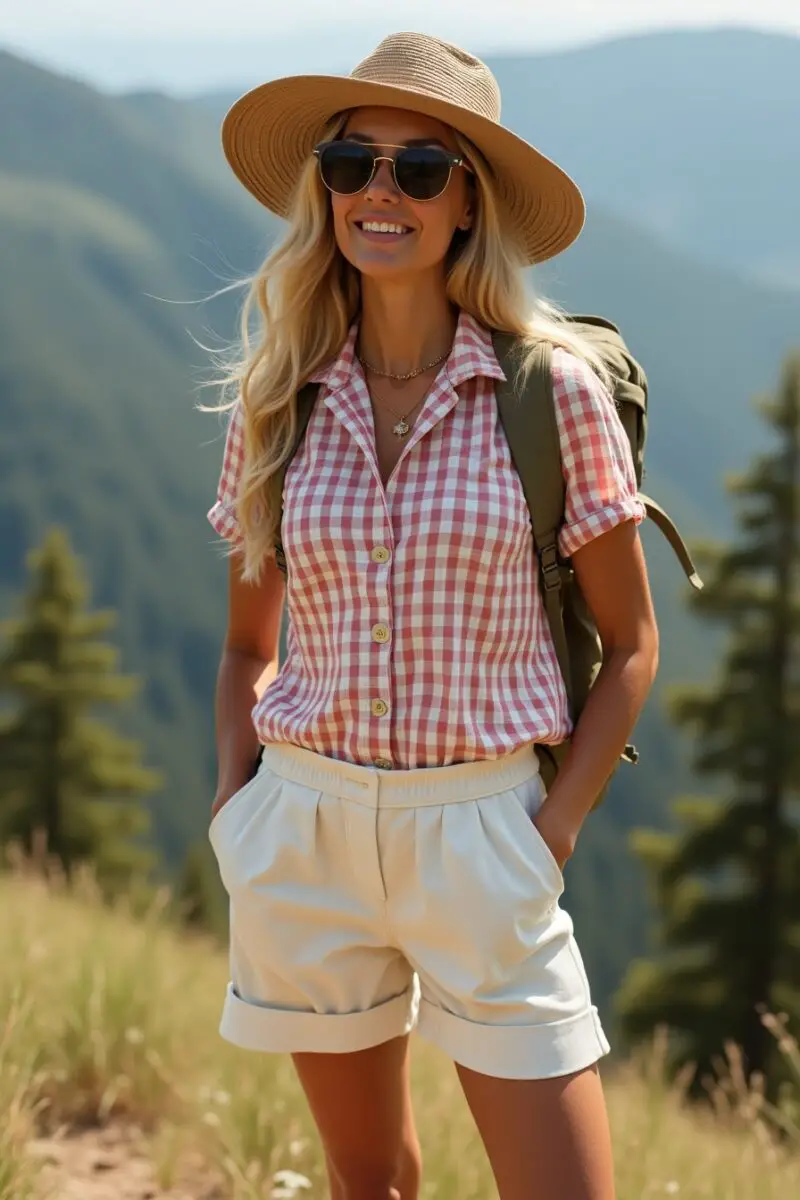
The Cottage Core Climber aesthetic has stolen hearts by brilliantly merging the romantic, pastoral vibes of cottage core with practical hiking necessities.
This whimsical yet functional style features flowy linen-cotton blend shorts or pants with practical pockets, often in soft floral prints or gingham patterns that evoke a sense of nostalgia.
Paired with these are puff-sleeved performance tops or button-up hiking shirts with delicate embroidery details that somehow manage to wick moisture while looking like they belong in a fairytale.
The color palette draws heavily from nature’s softer side – think lavender fields, buttermilk yellows, faded denim blues, and sage greens that create a dreamy, filtered look in photos.
Unlike purely aesthetic cottage core, these hiking versions incorporate technical features like reinforced seams, UPF protection, and quick-drying properties that stand up to challenging trails.
Layering takes on a romantic quality with lightweight quilted vests or oversized cardigans that can be tied around shoulders or waists when not needed.
Footwear balances the feminine elements with sturdy ankle boots in soft leather tones, often with subtle floral embossing or unique lacing systems that add character without sacrificing grip.
Accessories define this aesthetic – straw hats with secure chin straps, delicately patterned bandanas that double as sweat wipes, and woven crossbody bags lined with waterproof material.
Many cottage core climbers incorporate traditional hiking tools reimagined with vintage flair – wooden handled trekking poles or leather-wrapped water bottles that feel like heirlooms.
This style emphasizes natural fibers blended with performance materials, creating breathable garments that move naturally and develop character with every adventure.
The signature silhouette typically features a gently defined waist and relaxed fit that allows for scrambling over rocks or striding through meadows with equal ease.
What makes this aesthetic so captivating is how it transforms the utilitarian act of hiking into something poetic and storybook-worthy.
Hair is often styled in practical yet romantic braids or half-up styles, secured with handcrafted wooden pins or printed scrunchies that stay put during activity.
The cottage core climber doesn’t shy away from adornment – pressed flower phone cases, embroidered patches on backpacks, and even subtle vine tattoos often complete the look.
Beyond being Instagram-worthy, this style celebrates a connection to heritage crafts and simpler times while embracing the modern technologies that make outdoor adventures more accessible.
Techwear Trailblazer

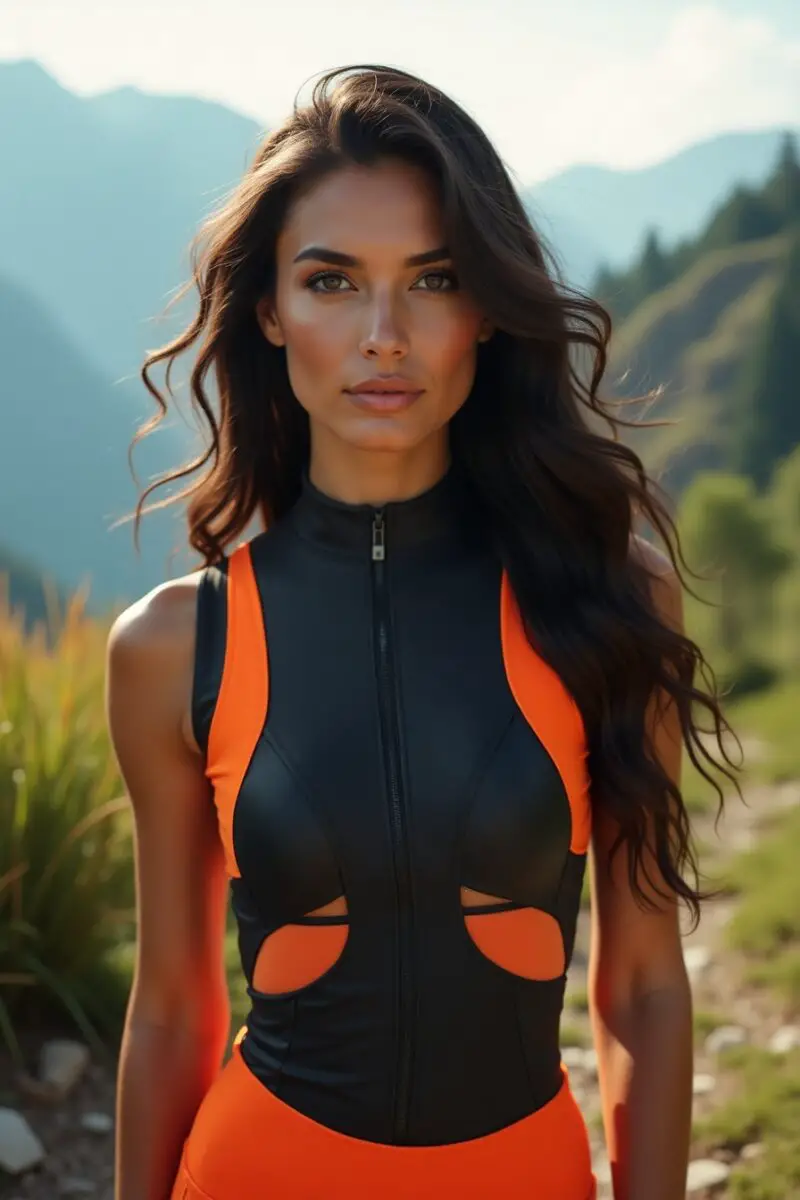
The Techwear Trailblazer aesthetic transforms ordinary hikers into sleek outdoor operatives with futuristic gear that looks straight out of a high-budget adventure film.
This cutting-edge style centers around ultra-technical fabrics with visible textures, architectural seam lines, and strategic paneling that enhances mobility while creating a distinctly urban-meets-wilderness silhouette.
The color palette is unapologetically bold with deep blacks, tactical grays, and unexpected pops of neon or reflective elements that stand out dramatically against natural backdrops.
Pants feature articulated knees, water-repellent nanotechnology, and an abundance of zippered compartments that eliminate the need for additional bags while creating an appealingly complex visual texture.
Tops layer strategically with compression base layers beneath lightweight shells that can be configured multiple ways depending on weather conditions and activity level.
The defining feature of this aesthetic is the emphasis on transformable pieces – jackets with removable hoods and sleeves, pants that convert to shorts, and wraps that serve as scarves, headbands, or even impromptu towels.
Footwear pushes boundaries with trail sneakers that incorporate BOA lacing systems, graphene-enhanced outsoles, or even electronic heating elements for cold weather excursions.
Accessories take center stage with futuristic eyewear featuring interchangeable lenses, smart watches that track everything from altitude to heart rate, and weather-resistant audio devices that keep playlists pumping while battling elements.
The silhouette tends to be slightly oversized but never bulky, with asymmetrical details and strategic cinching that creates a dynamic, action-ready appearance even when standing still.
Many techwear enthusiasts incorporate subtle LED elements or reflective paracord details that serve practical safety purposes while adding to the high-tech aesthetic.
What makes this style particularly fascinating is how it embraces innovation rather than tradition, constantly evolving as new performance materials and manufacturing techniques emerge.
The techwear approach extends beyond clothing to include modular backpack systems with customizable components that can be reconfigured based on the specific needs of each hike.
Despite its futuristic appearance, this aesthetic is deeply practical, often incorporating antimicrobial properties, enhanced durability, and climate-adaptive technologies that make long treks more comfortable.
Hair is typically worn in no-nonsense styles – sleek ponytails secured with silicone-grip ties or ultra-short cuts that require no maintenance on the trail.
The overall effect creates a powerful presence that suggests mastery over both technology and wilderness – a compelling combination that draws admirers both on and off the mountain.
Vintage Explorer
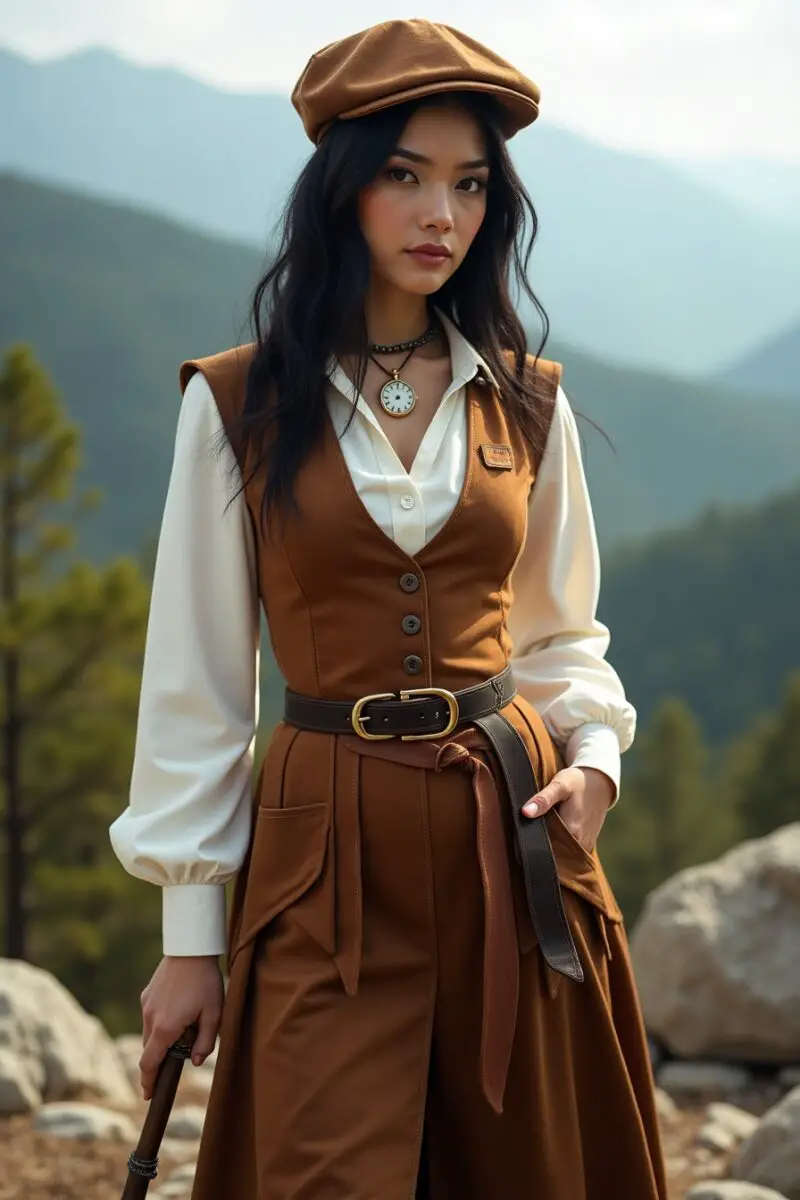
The Vintage Explorer aesthetic captures the golden age of outdoor adventure with retro-inspired pieces that evoke nostalgic wilderness expeditions while incorporating modern performance features.
High-waisted hiking shorts or pants in sturdy canvas or twill form the foundation of this look, often featuring reinforced knee patches and oversized utility pockets reminiscent of 1940s expedition gear.
Tops typically include button-up ranger shirts with epaulets and chest pockets, or merino henley pullovers that reference mountaineering classics while wicking moisture more effectively than their historical counterparts.
The color palette celebrates heritage hues – forest greens, tobacco browns, mustard yellows, and faded reds that have a slightly desaturated quality, as if they’ve already weathered countless adventures.
Layering follows traditional outdoor wisdom with wool sweaters featuring classic patterns like fair isle or cable knit, now updated with lighter weight fibers and thumb holes for practical modern wear.
Outerwear makes bold statements with waxed cotton jackets or reimagined versions of classic mountain parkas, complete with storm flaps and oversized buttons that serve as both functional elements and style features.
Footwear honors tradition with leather hiking boots featuring distinctive red laces and contrast stitching, though today’s versions hide modern cushioning and technical soles beneath their heritage appearance.
Accessories define this aesthetic – think leather-strapped compass watches, bandanas with vintage national park prints, and metal canteens wrapped in leather cases that clip to authentic-looking web belts.
Many vintage explorers complete their look with classic round sunglasses featuring colored lenses or reproduction frames that protect eyes while adding character to trail portraits.
The silhouette tends to be less fitted than contemporary styles, with intentional room for movement and structured shapes that create distinctive profiles against scenic backdrops.
What makes this aesthetic so compelling is its storytelling quality – each outfit seems to contain adventures already experienced and hints at the possibility of discoveries yet to come.
Many enthusiasts incorporate genuine vintage pieces like leather gloves or wool socks alongside technical modern items, creating a beautiful tension between function and history.
Hair styling often references practical traditions – bandanas folded as headbands, low braids with wisps that escape charmingly during climbs, or neat caps that shield from sun while adding period-appropriate flair.
Despite its throwback appearance, the vintage explorer aesthetic typically incorporates hidden technical elements like waterproof membranes, stretchy panels, and lightweight materials that make these outfits far more trail-friendly than their historical inspirations.
This style tends to age gracefully, with pieces that look even better with earned wear and tear – scuffs and worn edges add to the authenticity rather than detracting from the overall appearance.
Athleisure Alpinist

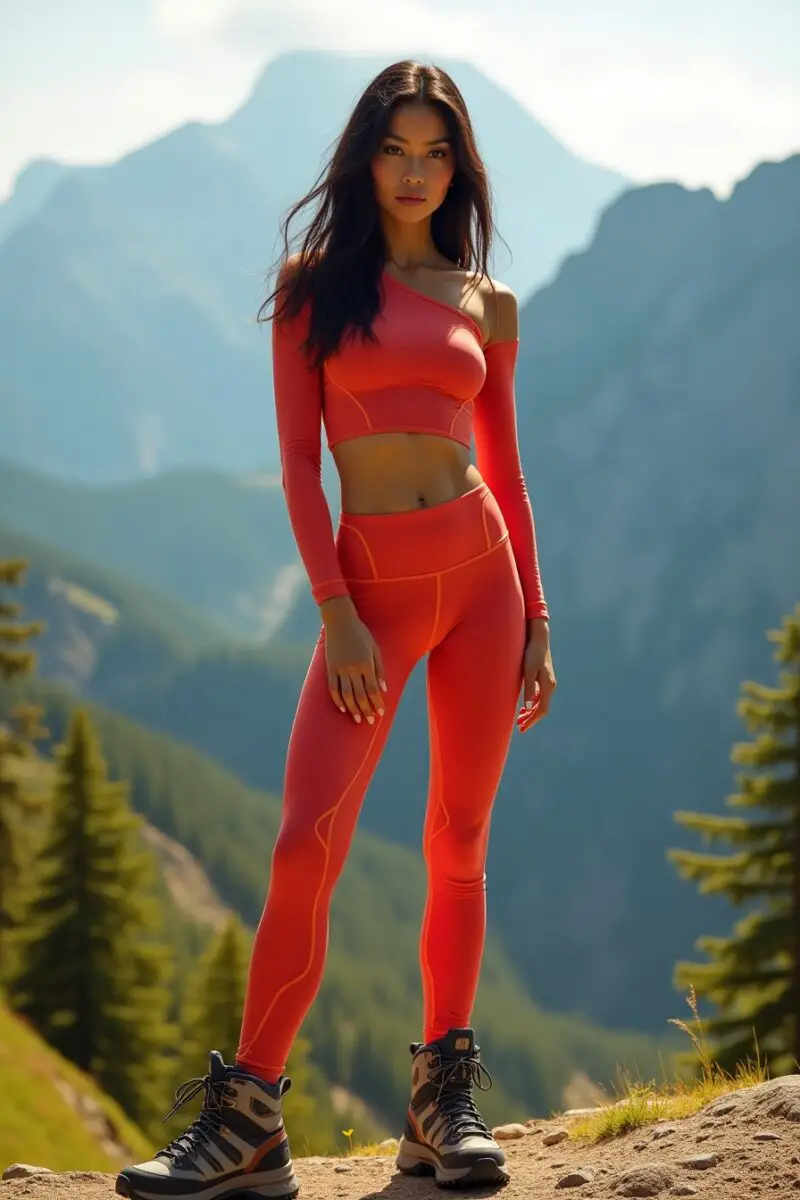
The Athleisure Alpinist brings runway-ready athletic style to challenging terrains, proving that performance and fashion aren’t mutually exclusive when conquering peaks.
This aesthetic centers around sleek compression leggings or shorts in eye-catching patterns – think marble swirls, abstract geometric prints, or subtle ombré effects that create visual interest while wicking sweat efficiently.
Matching sports bras paired with either crop tops or oversized performance tees create a layered look that can be adjusted as body temperature fluctuates during challenging ascents and descents.
The color story tends toward saturated jewel tones – deep teals, rich plums, electric blues – or alternatively, crisp monochromes with strategic color blocking that accentuates and flatters the body in motion.
Unlike gym-focused athleisure, these hiking versions feature reinforced high-rise waistbands with hidden zipper pockets perfectly sized for trail essentials like lip balm, energy gels, or small electronics.
Fabrics incorporate outdoor-specific technologies like UPF protection, insect repellency, and anti-odor properties while maintaining the second-skin feel that athleisure enthusiasts crave.
Outerwear follows the streamlined aesthetic with form-fitting windbreakers or packable puffers in complementary hues that can be tied around waists without creating unflattering bulk.
Footwear merges trail functionality with athletic style – often featuring knit uppers in bold colorways, distinctive lacing systems, and aggressive tread patterns that perform on technical terrain.
Accessories maintain the athletic vibe with sleek hydration belts, minimalist running caps, and wireless earbuds that stay secure during active movement on uneven ground.
Hair is typically worn in practical yet stylish options – high ponytails secured with spiral elastics, Dutch braids that keep strands contained during sweaty climbs, or slick buns that tuck neatly under caps.
What distinguishes this aesthetic is its emphasis on movement-enhancing design – strategic mesh panels for ventilation, four-way stretch fabrics, and seamless construction that prevents chafing during long-distance treks.
Many athleisure alpinists layer their looks with lightweight performance hoodies featuring thumbholes and adjustable hoods that frame the face flatteringly while providing sun protection.
The silhouette typically celebrates athletic physiques with contoured seaming and compression elements that support muscles during challenging elevation changes.
Despite its fashion-forward appearance, this aesthetic prioritizes technical performance with moisture management systems, quick-drying properties, and durability that withstands contact with rough terrain.
The overall effect creates a powerful image of athletic capability paired with style consciousness – someone who conquers difficult trails while looking effortlessly put-together from trailhead to summit.
Boho Backcountry Babe

The Boho Backcountry Babe aesthetic captures free-spirited adventure with flowing silhouettes and artisanal details that somehow stand up to demanding wilderness conditions.
This distinctive style features convertible hiking pants in lightweight, quick-dry fabrics with hand-embroidered details or batik-inspired prints that reference global textile traditions while performing beautifully on the trail.
Tops layer creatively with tank bases under kimono-style wraps or poncho silhouettes that provide sun protection and dramatic movement in trail photographs without restricting mobility during climbs.
The color palette draws from desert landscapes and exotic marketplaces – think terracotta, turquoise, saffron, and indigo – often mixed in unexpected combinations that create a signature look impossible to replicate.
Unlike purely decorative boho fashion, these hiking versions incorporate hidden technical features like reinforced gussets, strategically placed vents, and specialized trail fabric blends beneath their artistic appearance.
Footwear balances the ethereal elements with practical trail sandals featuring anatomical footbeds and serious traction, or lightweight boots adorned with woven textile panels and talismanic beadwork.
Accessories define this aesthetic – statement hats with stampede strings, handcrafted walking sticks collected from significant hikes, and belt bags wrapped with vibrant tassels or intricate macramé details.
Many boho backcountry enthusiasts layer multiple delicate necklaces featuring natural elements like small crystals or carved wooden pendants that hold personal meaning and create a distinctive tinkling sound during movement.
Hair embraces natural texture, often styled in loose braids intertwined with colorful threads, topped with printed headscarves, or adorned with tiny bells or beads that create gentle music with each step along the trail.
The signature silhouette typically features flowing layers that create dramatic movement in mountaintop photographs, contrasting beautifully with rugged landscapes while providing practical sun protection.
What makes this aesthetic so alluring is its celebratory approach to nature – every outfit seems designed to honor and blend with natural surroundings rather than stand apart from them.
Many boho hikers incorporate sustainable elements like upcycled fabrics, natural dyes, or handcrafted components that connect their gear to artisanal traditions while reducing environmental impact.
Unlike more structured hiking styles, the boho backcountry aesthetic celebrates asymmetry and imperfection, with intentionally uneven hems, raw edges, and one-of-a-kind embellishments that evolve with wear.
Despite its artistic appearance, this style doesn’t sacrifice function – hidden technical elements like mosquito-repellent treatments, reinforced seams, and specialized stretch panels ensure these beautiful garments perform as well as they photograph.
The overall effect creates a wanderlust-inducing image that inspires others to seek both adventure and beauty in equal measure – someone equally at home at a desert music festival or summiting a challenging peak at sunrise.
Normcore Nature Lover

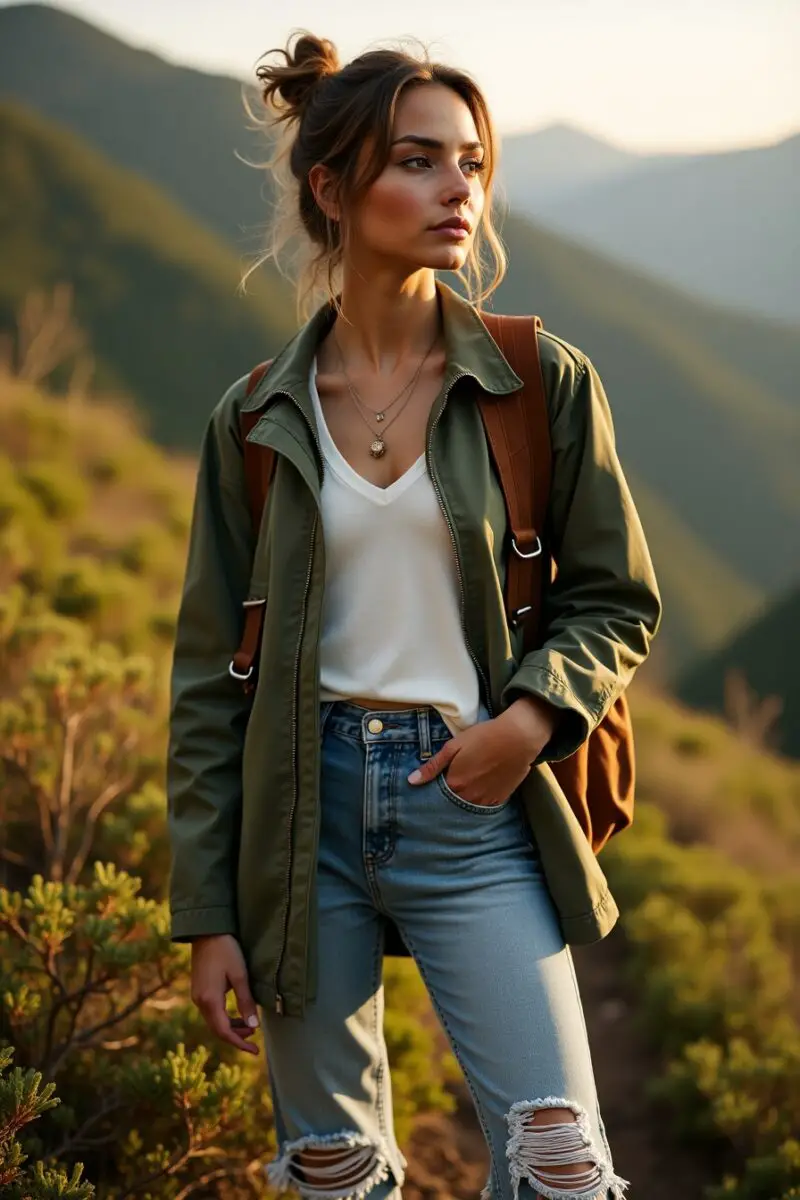
The Normcore Nature Lover aesthetic celebrates understated outdoor practicality with a distinctly cool, insider vibe that values function over flashy details.
This subtle style centers around classic hiking staples like zip-off convertible pants or straight-cut shorts in solid, mid-tone colors that don’t show dirt easily but somehow look effortlessly put-together in every setting.
Tops feature vintage-inspired logo tees from actual national parks or conservation organizations (never replicas), layered under basic flannel shirts or waffle-knit thermals that look better with each washing.
The color palette intentionally avoids trendy hues in favor of timeless outdoor classics – navy, forest, burgundy, mustard, and stone – often slightly faded as if the pieces have already logged serious trail miles.
What makes this aesthetic distinctive is its rejection of obvious technical features – no excessive zippers, visible moisture-wicking panels, or aggressive branding, despite the clothing actually containing high-performance elements.
Outerwear follows the same principle with unassuming soft-shell jackets or basic pullovers that outdoor insiders recognize as quality pieces while casual observers might mistake them for ordinary weekend wear.
Footwear epitomizes this approach with hiking shoes that resemble classic sneakers or boots that reference traditional work wear while hiding advanced cushioning and traction systems within their unassuming profiles.
Accessories maintain the understated vibe – simple ball caps from local trail organizations, basic webbing belts, and analog watches with altimeter functions concealed beneath traditional-looking faces.
Many normcore nature lovers carry genuine vintage external frame backpacks or carefully selected modern packs with minimal visible branding and classic colorways that won’t look dated in trail photos years from now.
Hair typically follows the low-maintenance approach – natural texture in practical styles without obvious products, perhaps tucked under a beanie that looks randomly chosen but actually features premium merino wool.
What distinguishes this aesthetic is its quiet authenticity – these outfits never try too hard yet somehow stand out among the flashier technical gear on crowded trails.
Many enthusiasts incorporate legitimately worn-in pieces from seasons past alongside carefully selected new items, creating an evolved collection rather than an assembled outfit.
The silhouette tends toward slightly relaxed without being baggy, allowing for unrestricted movement while maintaining a clean line that photographs well against dramatic landscapes.
Despite its casual appearance, this style prioritizes quality materials with natural and technical fabrics chosen for longevity and performance rather than trend cycles or seasonal updates.
The overall effect creates a trustworthy, knowledgeable image – someone who hikes for the pure joy of nature rather than for social media acclaim, yet consistently captures the most authentic trail experiences.
Preppy Peak Bagger
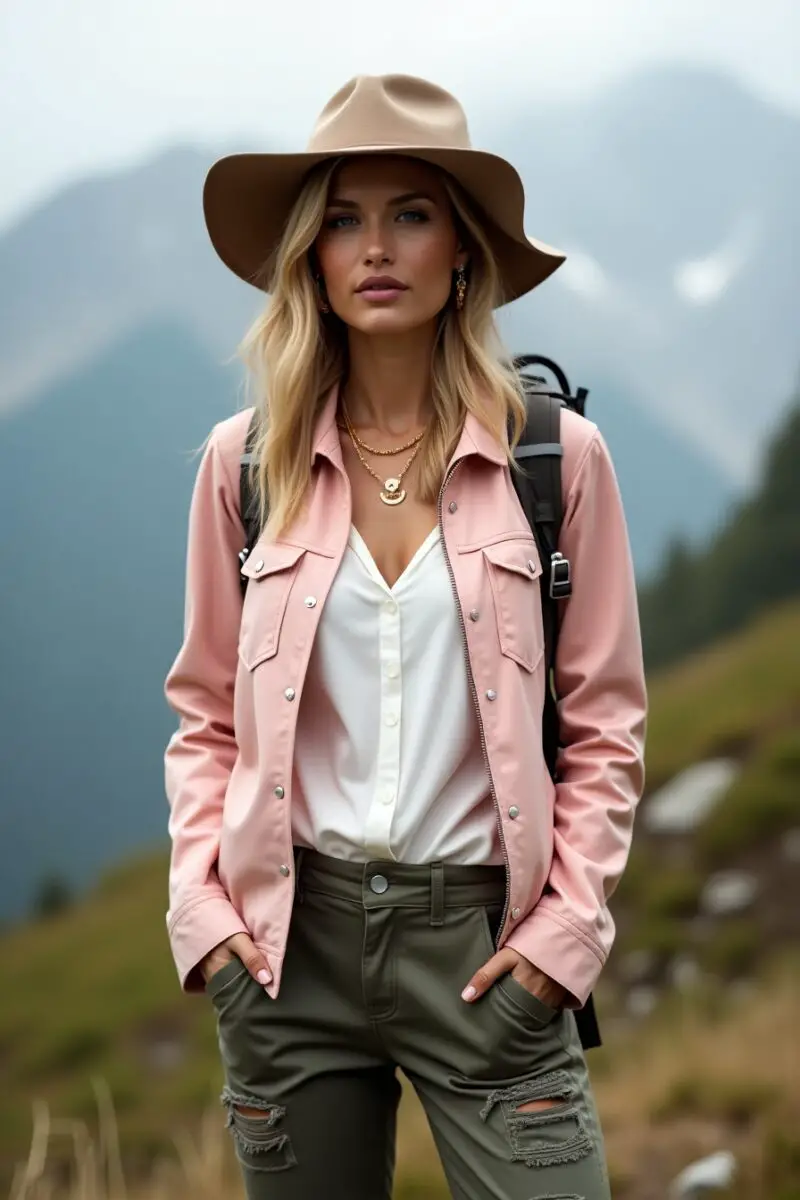
The Preppy Peak Bagger aesthetic brings polished, collegiate charm to mountain trails with structured pieces that prove wilderness adventures needn’t sacrifice refined style.
This distinctive look centers around tailored hiking shorts or skorts in madras plaids, neat ginghams, or solid piqué fabrics with contrast stitching and crisp cuffs that somehow stay presentable even during demanding summit pushes.
Tops layer thoughtfully with breathable button-up shirts featuring subtle embroidered details or tasteful monograms, often with sleeves neatly rolled to the elbow and collars popped for sun protection.
The color palette embraces classics with a twist – navy and white with unexpected pops of coral or lime, heritage tartans reimagined in performance fabrics, and traditional stripes scaled up for modern impact.
Unlike casual campus preppy, these hiking versions incorporate technical elements like hidden stretch panels, reinforced seat areas, and moisture-wicking properties beneath their country club appearance.
Outerwear makes a statement with quilted vests in distinctive patterns, lightweight quarter-zips with contrast piping, or packable anoraks featuring ribbon trim and brass hardware that elevates the utilitarian.
Footwear balances the refined elements with practical trail oxfords or hiking boots in rich leather tones with subtle brogue detailing, often paired with colorfully striped compression socks that peek just above the ankle.
Accessories complete the aesthetic with grosgrain-trimmed sun hats, needlepoint key fobs attached to water bottles, and polarized sunglasses in tortoiseshell frames secured with croakies in complementary patterns.
Many preppy peak baggers personalize their gear with embroidered patches from conquered mountains, leather luggage tags repurposed as zipper pulls, or vintage pins collected from national parks.
Hair typically follows the polished-yet-practical approach – neat ponytails secured with ribbon hair ties, French braids tucked through the back opening of baseball caps, or short cuts styled with minimal product for easy trail maintenance.
What makes this aesthetic so appealing is its aspirational quality – these outfits suggest membership in a tradition of well-heeled outdoor enthusiasm dating back to early Ivy League outing clubs.
Many enthusiasts incorporate family heirlooms like handed-down compasses or flasks alongside cutting-edge navigation devices, creating a charming blend of heritage and innovation.
The signature silhouette maintains a trim, tailored line without constraining movement – think pleated shorts with precisely the right amount of ease or skorts with carefully engineered undershorts that prevent riding up during steep climbs.
Despite its put-together appearance, this style prioritizes trail-ready performance with UPF protection, antimicrobial treatments, and hidden technical features that ensure these picturesque outfits stand up to serious outdoor challenges.
The overall effect creates a timelessly appealing image – someone equally comfortable discussing summit strategies or hosting an impromptu streamside picnic complete with proper drinkware and linen napkins.
Tactical Trail Queen
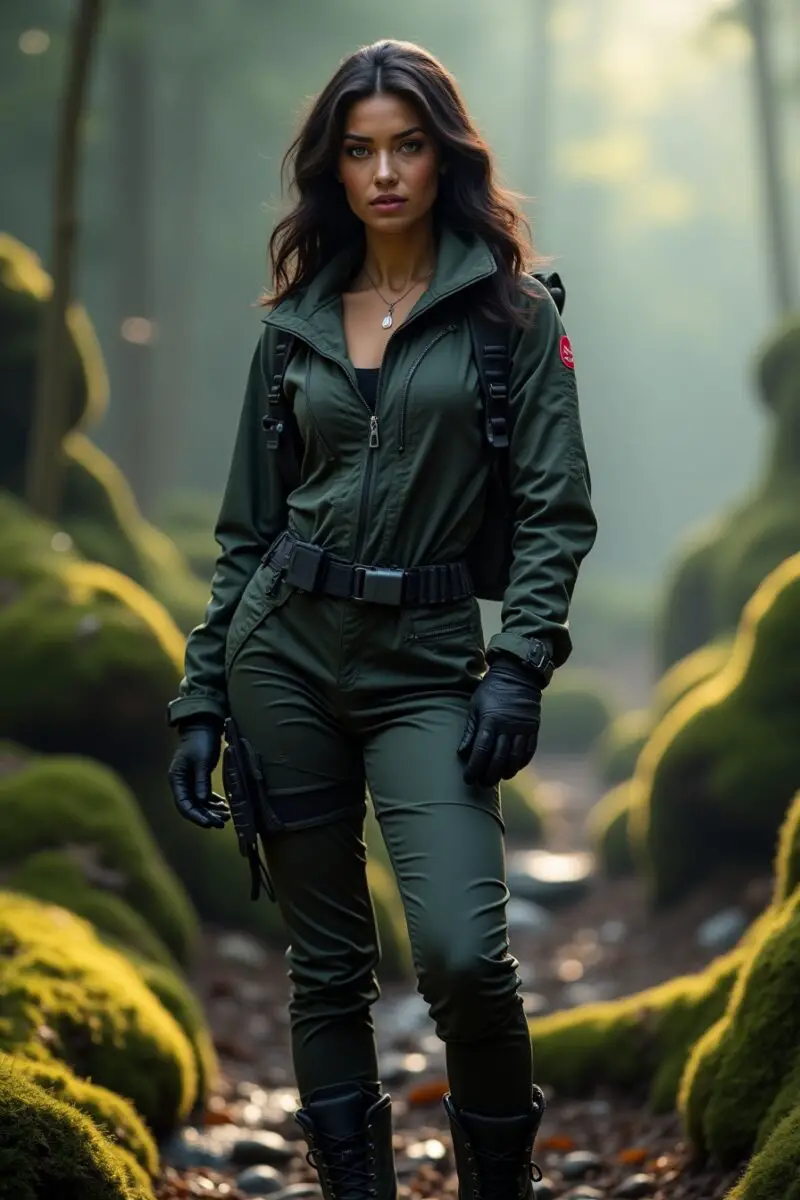
The Tactical Trail Queen aesthetic brings military-inspired precision and hardware-heavy details to female hiking apparel, creating a boldly capable look that commands respect on challenging routes.
This distinctive style features convertible cargo pants or shorts with reinforced ripstop fabric, abundant pocket configurations, and adjustable features that allow customization for different body types and trail conditions.
Tops layer strategically with moisture-wicking base layers beneath button-up hiking shirts featuring sleeve tabs, ventilation panels, and technical fabric blends that perform in extreme conditions while maintaining a structured appearance.
The color palette honors tactical traditions with olive drabs, desert tans, and shadow grays, occasionally punctuated with unexpected touches of burgundy or deep teal that add feminine flair without compromising the authoritative vibe.
Unlike fashion-focused military looks, these hiking versions incorporate genuine outdoor technologies like waterproof zippers, radio loops, and specialized fabrics developed for actual field operations.
Outerwear makes a statement with angled pockets, reinforced elbows, and modular attachment points that allow for customizing layers based on changing weather conditions or specific trail requirements.
Footwear completes the aesthetic with serious hiking boots featuring speed-lace hooks, vibram outsoles, and ankle support systems designed for carrying heavy loads over difficult terrain.
Accessories define this look – think full-featured multitools attached to belt loops, paracord bracelets woven in distinctive patterns, and tactical sunglasses with interchangeable lenses for different light conditions.
Many tactical trail enthusiasts incorporate functional equipment like carabiners, compact monoculars, or specialized navigation tools that clip to purpose-designed attachment points on their clothing.
Hair follows the practical approach – secure braids, ponytails threaded through cap openings, or short cuts that require no maintenance during multi-day expeditions in challenging environments.
What makes this aesthetic so compelling is its emphasis on capability – these outfits suggest serious outdoor skills and preparedness for whatever challenges the wilderness might present.
Many enthusiasts customize their gear with velcro patches representing completed challenges, specialized modifications for preferred activities, or personal adaptations that improve functionality for their specific needs.
The silhouette tends toward a tapered approach – roomier through shoulders and thighs to allow movement while narrowing at wrists and ankles to prevent snagging on branches or rocks during technical passages.
Despite its rugged appearance, this style often incorporates surprisingly thoughtful details for female hikers – strategically placed stretch panels to accommodate curves, adjusted pocket positioning for women’s proportions, and specialized features for hygiene management during extended backcountry trips.
The overall effect creates a powerfully competent image – someone prepared to handle emergency situations, navigate challenging terrain, and assist less experienced hikers while maintaining composure in any wilderness scenario.
Gorpcore Goddess
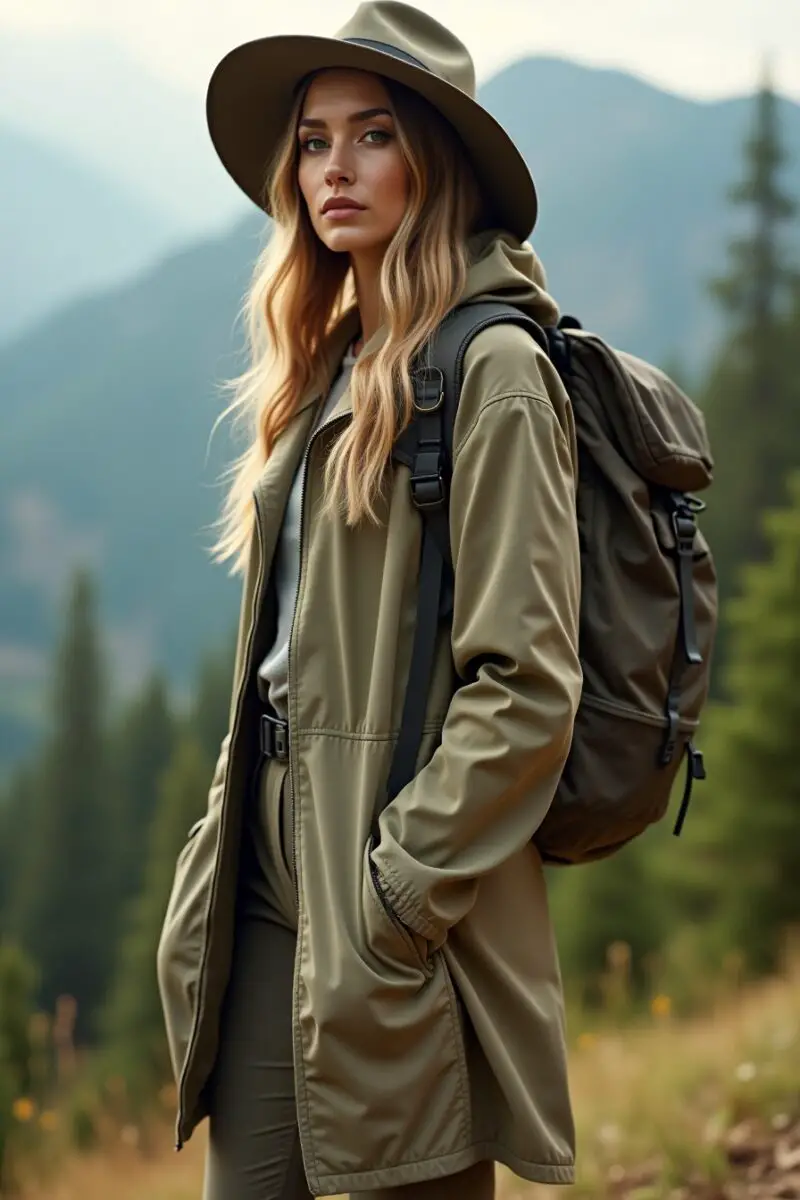
The Gorpcore Goddess aesthetic celebrates technical outdoor gear in its purest form, embracing the vibrant colors and distinctive silhouettes of serious mountain equipment as fashion statements in their own right.
This increasingly popular style features classic hiking silhouettes like high-performance shell pants, insulated bibs, or technical shorts from authentic outdoor brands, worn with pride and zero irony about their specialized appearances.
Tops layer according to genuine outdoor principles with moisture-wicking base layers, insulating mid-layers, and weather-resistant outer shells combined in unexpectedly appealing color combinations that pop against natural backdrops.
The color palette rejects subtlety in favor of the vivid hues traditionally associated with visibility and safety – electric blues, neon yellows, vibrant purples, and flame oranges often color-blocked in distinctive patterns recognizable to outdoor enthusiasts.
Unlike fashion-first hiking looks, gorpcore embraces actual performance features – storm flaps, taped seams, reinforced crampon patches, and articulated joints designed for technical movement in challenging terrain.
Outerwear takes center stage with expedition-grade down jackets, technical hardshells with helmet-compatible hoods, or vintage fleece pullovers in distinctive patterns that reference specific decades of outdoor culture.
Footwear follows function with serious approach shoes, alpine boots, or trail runners selected for their technical capabilities rather than aesthetic appeal, yet somehow looking perfectly coordinated with the overall ensemble.
Accessories remain thoroughly practical – genuine climbing chalk bags repurposed as purses, ice axe loops holding water bottles, and actual rescue whistles attached to zipper pulls that could serve their intended purpose if necessary.
Many gorpcore enthusiasts layer unexpected combinations – pairing technical climbing pants with oversized fleece pullovers, or matching alpine shells with cropped base layers in contrasting colors that create distinctive silhouettes.
Hair accommodates the technical requirements of the activity – tucked under beanies with reflective elements, secured in braids that fit under climbing helmets, or cut short for minimum maintenance during extended outdoor pursuits.
What distinguishes this aesthetic is its celebration of outdoor functionality as inherently beautiful – rejecting the notion that technical gear should be disguised or dressed up to be stylish.
Many enthusiasts incorporate legitimately weathered pieces showing signs of actual adventures alongside newer items, creating an authentic collection that tells the story of real outdoor experiences.
The silhouette typically features a distinctive contrast between fitted base layers and more voluminous outer layers, creating a cocoon-like effect that photographs dramatically against mountain landscapes.
Despite its technical appearance, this style often incorporates unexpected styling choices – pants rolled to show colorful compression socks, jackets left partially unzipped to reveal contrasting mid-layers, or accessories from different outdoor disciplines mixed in surprising combinations.
The overall effect creates an image of authentic outdoor enthusiasm – someone who values genuine mountain experiences and the specialized equipment that makes them possible while finding beauty in the distinctive visual language of technical gear.
The evolution of hiking fashion demonstrates how outdoor enthusiasts continue to blend personal expression with practical functionality in increasingly creative ways.
The best hiking outfits balance personal style with respect for the natural world, incorporating sustainable materials, durable construction, and versatile designs that reduce consumption while maximizing enjoyment.
Whether you’re drawn to the romantic cottage core aesthetic or the bold technical statements of gorpcore, the most important aspect of any hiking outfit is how confidently and comfortably it allows you to explore wild places.
Remember that the most authentic trail style is one that evolves naturally through actual outdoor experiences, accumulating stories and adaptations with every summit reached and river crossed.

